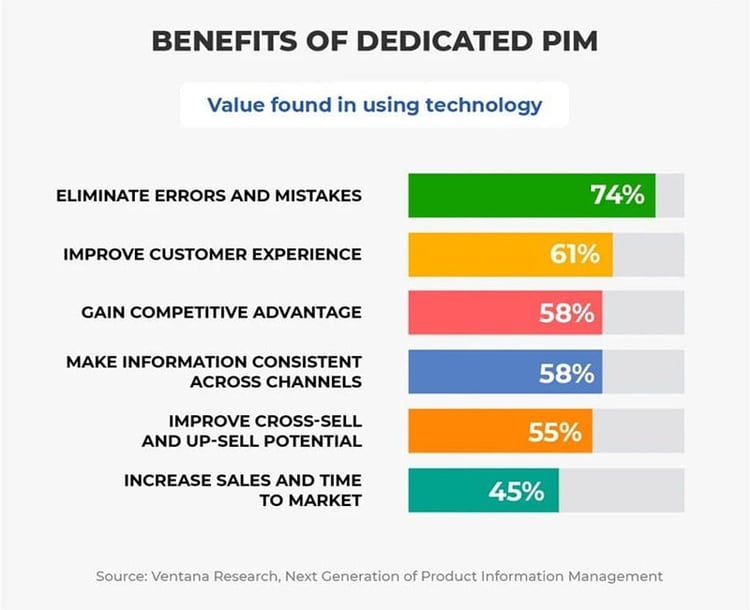PIM for Construction: 9 Ways PIM Platform Brings Harmony and Efficiency

Table of Contents
- Digitalizing construction — key industry challenges
- Product information management in the construction industry
- Why do distributors and manufacturers need a PIM solution?
- How can PIM help future-proof a construction company? [9 benefits]
- Case study: How Saint-Gobain Distribution Norway leverages the PIM platform
- Summary
The construction industry plays a vital role in the global economy, driving investment, innovation, and urbanization. After unstable times caused by economic and health crises, it is possible that the industry has a bright future.
As Global Construction Futures shows, over the next 15 years, global construction activity is projected to surge, with work reaching a staggering US$13.9 trillion by 2037 — an increase of over US$4.2 trillion from the 2022 figure of US$9.7 trillion.
The construction and building sector is distinguished by its diverse range of products, complex requirements, and multiple stakeholders involved. In this dynamic ecosystem where quintillion bytes of data are produced daily and one of the most impactful technologies is big data, managing data has become a significant challenge. According to The State of Data Capabilities in Construction report, 80% of construction companies still have room to improve their data capabilities.
In this article, we explore the challenges faced by the construction industry in the digital age and introduce a practical solution: a Product Information Management (PIM) platform that helps construction companies comprehensively manage product data to strengthen their market presence.
Digitalizing Construction — Key Industry Challenges
What characterizes construction can often be a significant challenge in digital transformation.
The sector involves numerous stakeholders with varying levels of technological proficiency, making it difficult to implement standardized digital solutions. Additionally, construction projects tend to be complex and unique, requiring customized digital tools that may not always be readily available or easily integrated.
Let’s look at some typical hurdles building companies often face while adopting digital technologies:
-
Legacy systems and processes: Many construction companies still rely on outdated systems and processes, making it challenging to integrate new digital technologies seamlessly.
-
Fragmented data and communication: Construction projects involve multiple parties, leading to data silos and fragmented communication.
-
Interoperability issues: Different software and tools used in construction may not always be compatible with each other, leading to interoperability challenges. Ensuring seamless integration between various digital platforms is crucial for maximizing efficiency.
-
Composite regulatory environment: Construction projects are subject to various regulations and compliance requirements, which can add complexity to the adoption of new digital technologies.
-
Project complexity and variability: Construction projects can range widely in size, scope, and complexity.
Addressing them in an organization requires a comprehensive approach that involves investment in technology, workforce development, and a cultural shift.
Product Information Management in the Construction Industry
A large number of processes and parties involved and complex documentation generate tons of product information. It is no surprise that construction companies, particularly in the retail and manufacturing sectors, may struggle with product information management.
These include keeping information consistent across different platforms, handling a wide range of product details, ensuring data accuracy, dealing with frequent updates, and communicating effectively with suppliers and customers. Luckily, a Product Information Management solution can help with all of this.
Product Information Management (PIM) is a process that involves collecting, organizing, enhancing, and sharing product details across various sales and marketing platforms. These actions can be accomplished using a dedicated PIM system that gathers product data from different places to create one central repository for all product information and enables its enrichment and distribution.
Why Do Distributors and Manufacturers Need a PIM Solution?
Regularly, construction distributors extract information from various sources, including manufacturers. Yet information must be tailored to a specific channel and customer needs. This is one of the cases where automation saves hours of manual work. PIM systems support them in:
- Centralizing product information
- Effective content delivery
- Fast and seamless integration between different systems and platforms
- Enhanced productivity
- Creating a structure of product information
For instance, Neumann, a leading B2B distributor of construction products in Norway, uses the Bluestone PIM platform as the master copy for all product information, making it possible to enrich or override industry database content as needed. Learn more about how the company has developed efficient processes for managing product information.
PIM boosts data operations by automating tasks and streamlining processes, allowing you to achieve more with less effort and ensuring high-quality data and product content without overloading your team.
The study we conducted with Ventana Research shows that 74% of surveyed companies aim to use a PIM solution to prevent data errors and inaccuracies.

How Can PIM Help Future-Proof a Construction Company? [9 Benefits]
The agility and wide range of capabilities of Product Information Management platforms respond to the complexity of the construction industry.
Below you will learn how PIM specifically supports marketers, business development, and sales departments of building companies in their daily work.
#1 Centralizing Product Information
The State of Data Capabilities in Construction report found that construction managers and executives spend an average of 11.5 hours a week researching and analyzing data. Gathering data in one central repository that acts as a single source of truth can save a lot of time.
A PIM makes it possible to centralize all relevant product information in one place, ensuring all teams have access to the latest, accurate data regardless of location. For example, a manufacturer can consolidate spec sheets, brochures, catalogs, bids and other critical documents from different regional teams in a single PIM.
#2 Managing High Volumes of Product Data
Building product portfolios contain vast numbers of SKUs and variants; a PIM provides the ability to easily ingest, store, and manage these at scale. A home builder offers 10,000 varieties of standard and custom home designs; a PIM allows easy management of this complex product portfolio.
#3 Product Information Enrichment
The PIM system enables standardized and simplified processes to enrich product information with detailed attributes, specifications, materials composition and certifications. This way, for instance, engineers can systematically include environmental certifications, load-bearing info, installation instructions, etc. for each product fitting SKU to facilitate compliance.
What's more, with AI features in PIM platform, you can generate engaging product descriptions and translate them lightning-fast for single or multiple products at once.
#4 Optimizing Product Information
Within PIM software, teams can take advantage of workflow tools to review, approve, and publish consistent, high-quality product content for websites, catalogs and other customer-facing materials. Marketers can ensure consistent messaging across all materials shown on the company website and third-party sites.
#5 Streamlining Collaboration
Intuitive collaboration features foster efficient internal cooperation between groups like engineering, marketing, sales, etc. to develop and maintain product information. Cross-functional teams jointly update documentation for new materials using a PIM's commenting and review tools.
#6 Managing Digital Assets & Documentation
A PIM becomes the single source of truth for storing, finding, and reusing product images, documents, manuals and compliance documentation. You can store all these digital assets in native DAM (Digital Assets Management) module or sync with external DAM and connect them to relevant product data in PIM.
#7 Product Information Distribution in Multiple Channels
Consistent information can be syndicated from the PIM to all sales and eCommerce sites, marketplaces, CRM systems and third-party providers. For companies that rely on multiple channels, the PIM platform can send information necessary for orders to e-commerce solutions on a website, mobile devices, or e-procurement portals.
#8 Data Syndication
In PIM, product content is automatically syndicated to downstream systems, avoiding manual re-entry and reducing human error. For example, changes to concrete types and technical data are automatically syndicated from the PIM to downstream CPQ and ERP systems.
#9 Boosting Product Experience
Customers ultimately benefit from always having accurate, complete product information at their fingertips, no matter where or how they engage with a company. Homebuyers appreciate finding comprehensive specifications for appliances, fixtures and finishes from their preferred builder's mobile site.
Case Study: How Saint-Gobain Distribution Norway Leverages the PIM Platform
Now let's look at an example of how PIM works in practice.
See how Saint-Gobain Distribution Norway, a leading distributor of construction materials, timber, and interiors in Norway, uses the Bluestone PIM platform to scale their operations.
The Challenge
Characterized by its complex enterprise structure, Saint-Gobain Distribution Norway leverages different solutions and integrates product data from various sources like ERP, NOBB (Norwegian Industry Database), and Excel.
One of the most valuable sources is data provided by suppliers. The company needed a dedicated space that enables suppliers to share product information in a highly controlled manner.
The Solution
Bluestone PIM is the leading composable PIM platform.
Built on open and modular MACH architecture (Microservices-based, API-first, Cloud-native, and Headless) is distinguished by its speed, high flexibility and scalability. The solution allows businesses to connect and share their product information with other software, marketplaces or platforms.
Moreover, as a PIM solution designed for composable commerce, Bluestone PIM can be merged with other best-of-breed solutions to respond to complex business requirements.
The Outcomes
Bluestone PIM integrated all Saint-Gobain Distribution Norway data layers from various solutions and frameworks. Features such internal supplier portal and completeness score enhanced productivity in the teams' collaboration and changed the way the company collaborates with subcontractors.
Curious about the details of this case study? Download the Saint-Gobain Distribution Norway Case Study ebook.
To learn more about the success of our clients' businesses after implementing Bluestone PIM, visit our case study collection page.
Summary
With the right PIM platform, construction businesses can effectively manage their product data, strengthen their market presence, and ultimately scale their operations.
Embracing technology like PIM is key to staying competitive in the ever-evolving construction landscape. To learn more about how PIM can benefit your business, explore further and consider implementing this powerful solution for your organization's success.
Bluestone PIM platform enables easy access to product data, enriches product content with AI features, simplifies collaboration among team members, and ensures accuracy in product information across various channels. By utilizing Bluestone PIM, construction businesses can enhance their competitiveness, reduce errors, and drive growth in the industry.
Schedule a free consultation with our PIM consultants, take a video tour, or book a personalized demo session and discover the possibilities of Bluestone PIM, the leading composable PIM solution.





